A different sort of entry this time round as I’ve been traveling and met with some extraordinary people and want to convey some of their hard-won optimism amid the heartbreak. If you haven’t already, please take five and call your Senators and urge them to remove the provision in the Reconciliation Bill requiring the sale of millions of acres of public lands. And don’t be afraid to attend a protest of the ICE raids or anything else Trump; all the ones I’ve attended have been peaceful and reassuring.
Our home for the week on the River Una in Bosnia and Herzegovina. Photo: Jan Pirnat
Three weeks ago, I flew a very long way to visit a beautiful, living river carrying a book that asks, in its title, Is a River Alive?
The British naturalist Robert Macfarlane’s latest had conveniently gone on sale a couple of days before I boarded my flights from LAX to Amsterdam and Zagreb, Croatia. Once in Zagreb, my colleague Louise and I planned to pick up a rental for the three-hour drive into Bosnia. Our destination: the Nacionalni park Una (Una River National Park), where local people and authorities are doing their best to protect their river from dams and other forms of damaging development, much like the river keepers on three continents in Macfarlane’s book.
At the Zagreb airport, we added a last-minute passenger, a Scotsman suffering heat exhaustion. He sat in back as the A/C cooled the car. Louise and I did our best to keep things upbeat as the on-board nav system ponged objections to our speeding and choice of route. Lou smugly stuck to her Google Maps as we got off course; my ridiculously bad sense of direction didn’t help. Two kilometers short of our destination, two Croatian border patrolmen stationed in a pickup truck turned us around. Directed back up the valley an hour to a safer bridge, we were eager for a silver lining. “Hedgehog!,” our backseat Scot blurted out, as if on cue, speaking for the first time in an hour. We paused to enjoy the critter nosing along the left rut of our unpaved road.
The three of us were, in the end, the last to arrive for our conference—though camp is the better word for it. A summer camp for adults looking to share ideas for protecting rivers and restoring ecosystems all while providing a livelihood for people. For the next four days and nights, we slept in yurt-like tents, dined at picnic tables, shared two hot showers (not all at once, we’re modern hippies). If we dared, we could also embrace a pre-coffee “embodiment practice” with the judgiest group counselor it’s ever been my privilege to disappoint.
A French-born dancer and chi kung practitioner living in Amsterdam, this Judgy Guru, or J.G., had asked that we all bring a sample of water from our home river for a shamanic welcome ceremony. Had a fun outing and swim in the Ventura River to collect my one ounce (to remain TSA compliant) contribution. I rather liked seeing the bowl of blended waters under our principal meeting tent; led me to reflect that we’re all bodies of water, really, beginning at birth, when we’re three-quarters agua.
The J.G. had a several thought-provoking ideas like this up her sleeve. She also succeeded a bit too well in her self-assigned role of getting us from of our comfort zones. When we first met, I attempted a positive spin on our Google Maps detour, saying if Lou and I hadn’t gone the wrong way, we’d never have seen the hedgehog.
“Hedgehogs are nothing,” the J.G. said. “If you’re excited about a hedgehog, this is going to be a big week for you.”
“I guess I’m easy,” I offered.
“You are,” she said with startling finality.
Opening night. Vanja Lazic, the artist who did the illustrations on the banners, attended the camp. Once she caught me looking forlorn into my cup—all that remained of my cowboy coffee was the silt, or meat, of the coffee. Her grandmother, she told me, used to read fortunes in the surface of the grinds. Photo: Jan Pirnat.
Sponsored by the European office of my employer, Patagonia, the camp, entitled Tools for Grassroots Activists, gathered four dozen or so environmental non-profit leaders and campaigners, graduate students and wildlife advocates—and, on the fourth and final night, a handful of middle-aged, ‘80s-anthem, badass Balkan rockers. They gave love a bad name.
Each day consisted of presentations and panel discussions in 45-to-60 minute blocks, plus a few workshops, usually under one main tent, everyone sitting on the grass, a yoga mat, or a basic bench that looked liberated from a Little League dugout. Nearly all of us took a turn speaking before the group. By lunch the second day, you knew who’d raise their hand first during the Q & A.
Naturally, things got exciting when the presenters disagreed.
“As a Buddhist, I don’t like using this word ‘fight’ anymore,” Pascal Rösler said. A German who left banking to paddle the 1,553-mile length of Danube River on a SUP, Rösler said he’d sworn off fighting words to focus on the promise of everyone coming together to get the Danube drinkable again by 2042. Two seats over, I could see Uli (Ulrich) Eichelmann shifting in his seat. Another German who has campaigned against dams on the Tigris and Danube, Eichelmann gave a bit of a Popeye ‘I am-what-I-yam’ shrug.
“You’ve got to seek out the conflict and go into it,” Uli said. “I live for ‘the fight.’”
Many of those present surely came for such moments of solidarity, but most of all they came to swap strategies for defending rivers. And, as Macfarlane makes clear in his book, it makes a ton of sense to center rivers in conservation and climate repair work.
“We take for granted that we take rivers for granted,” Macfarlane writes in his introduction.
“It is unremarkable that flowing fresh water can be owned, for instance — can be privatized and sold, reduced to liquid asset —or to think that access to a river’s banks may be tightly controlled or forbidden, rather than part of a blue commons. It is normalized that a corporation, in the eyes of the law, is an entity with legal standing and a suite of rights, including the right to sue—but that a river that has flowed for thousands of years has no rights at all.”
A few paragraphs later, Macfarlane suggests, as an exercise, that we hold a map of our own country in our minds.
“Imagine it now entirely blacked out except for the rivers and streams; these alone are present. Let them glow in vivid colours — blue and green, scarlet and violet… The land is suddenly intricately veined. Ridgelines show as dark, wandering absences; catchments gather fine filaments of water, braids them expertly into threads, ropes. Tilt — and zoom. The patterns repeats, then repeats again with each scale-shift: a fractal branching of tributaries and channels, fronds and stems. It resembles a vascular system. It resembles a neural network.
Everyone lives in watershed.”
Some re-mapping—this much I anticipated from our camp, too.
What I did not anticipate, but came to greatly appreciate, was the entrepreneurial spirit espoused by the mostly not-for-profit presenters. My European colleagues had managed to convene a bunch of self-starters with decidedly practical approaches. Maybe that’s why I found the J.G. jarring. Much as I’m up for a bit of woo-woo and self-discovery, our camp was more ‘can-do’ than kumbaya.
We learned about energy cooperatives, impact investing, and how to establish secondary revenue streams to underwrite field studies and tourist infrastructure in nature reserves. Also, how to win a river the legal right to exist—a theme of Macfarlane’s Is a River Alive?
One presenter at our camp, Grant Wilson, from the Earth Law Center in San Francisco, emphasized how crucial it is to identify the appropriate plaintiffs for lawsuits on behalf of a river. For two generations, the Kukama people on the Marañón, in Peruvian Amazon, suffered from upstream oil spills. “Their kids had to bathe in oil slicks. Fisheries collapsed. There were high rates of miscarriages and chronic illnesses,” Wilson said.
A group of Kukama women, through the president of their federation, Mrs [Mari Luz] Canaquiri Murayari, requested the courts to recognize the Marañón River as having rights—including the right to be free of oil. On March 18, 2024, she won. Among the rights secured for the Marañón:
The right to flow;
The right to exist and support a healthy ecosystem;
The right to flow free from all contamination;
The right to be fed and to feed its tributaries;
…The right to be restored.
“In the worldview of the Kukama people, the river is a living being that is home to different forms of life, as well as the Kukama ancestors,” Wilson said. “The Kukama women have now been appointed guardians of the river, and the oil company Petroperú has been ordered to update its environmental management plan and to better maintain the oil pipeline that for years contaminated the flow of the Marañón River.”
Kristine Tompkins kicked off the camp’s formal program with a pre-recorded keynote. Patagonia’s first chief executive officer, Kris left the company in 1993 to join her future husband, Doug Tompkins, off-the-grid in a rainforest in Chile. Over the decades that followed, the couple purchased huge tracts of land, starting with the forest they lived in, to donate back to the state as national parks in both Chile and Argentina. (If you’re unfamiliar with Kris and Doug’s story, a good place to start is Chai Vasarheyli and Jimmy Chin’s Nat Geo doc Wild Life.) After losing Doug to a kayak accident in December 2015, Kris has continued their ambitious conservation efforts and prepared her network of activists to outlive her, too.
In camp, we were joined by Camila Chebez. Camila is the daughter of Sofía Heinonen, the woman Doug hired back in 2005 to figure out how to return rare and technically extinct species to the Iberra region in northern Argentina. In her mid-twenties, a few days shy of defending her master’s thesis, Camila shared how her mom had moved her, age five, to Iberra, and how, as she grew up, she witnessed the return of capabarra, macaws and jaguar.
Doug Tompkins, Camila said, had first offered the job of bringing back the jaguar et al to her father, a former park superintendent, right as her parents divorced. Her dad turned Doug down. Her mom, hearing of this, approached Doug about the role. Over the course of several conversations, plus fly-overs of the region in Doug’s bush plane, Sofía won the gig. “Isn’t that one of the best divorce-revenge stories ever?” Camila asked, smiling.
Camila Chebez, of Rewilding Argentina. Photo: Jan Pirnat
In her keynote, Kris said something that came up a lot over the course of the camp, that having too many tourists wanting to visit one of the parks she helped establish “is a problem I want to have.”
Tourism has always been double-edged. Done right, it recruits devotees to an area and helps to raise funds to defend it. Or it can lead to a fragile place, or body of water, being overrun, or loved to death, as we say.
This remains a core concern for officials at River Una National Park, and for Besjana Guri, a fellow camper and recent winner of the Goldman Prize for her role in establishing the Vjosa Wild River National Park in Albania. Four fellow campers—grad students from Erasmus University in Rotterdam—forewent shots of rakia, the local moonshine, to put the finishing touches on their proposals for how to cover the operational costs at Una River National Park. Another guest, Andrej Sovinc, crashed this conversation with a bag of salt.
A civil engineer-turned-wetlands specialist, Sovinc hails from Slovenia, and clearly has some Steve Jobs in him. After completing a biological survey of the lagoons where the Dragonja River reaches the Adriatic Sea, he worked with a sponsor, a mobile phone company, to rebrand the salt harvested from the flats there. Now a gourmet seasoning sold in airports and touted by celebrity chefs, the salt’s sales pay for the infrastructure and ranger salaries at Secovlje Salina Nature Park. Could cherries or wild blueberries, abundant near our camp, do the same for Una River National Park?
As will happen at a conference with fifty people, not every schedule held. Bruno D’Amici, a terrific underwater photographer, missed one of his panels while snorkeling. Another panel ran long. And so, toward the end of the second day, Lou and the team of organizers needed to re-order things a bit. And that’s when the Judgy Guru struck again.
The team were trying to find a new time for Steve Weiss to give his talk. An able guitarist and campfire song leader as well as professor of ecology, Weiss contributed an essay to the conference program, “Dirty Dams: Busting the Myth of ‘Renewable’ Hydropower.” My colleague Louise was eager to post his new time.
“You’re spiraling,” the J.G. told Lou.
“No, I’m OK, I just really need us to focus and make a decision—”
“No, no. You’re not OK,” the J.G. insisted.
Louise hesitated.
“I want you to loosen your jaw. Relax it,” the J.G. went on, firmly. Lou obliged. If she could do what the J.G. wanted, she thought, maybe they could move on to what she wanted: a quick decision on Steve’s scheduling.
“Now, I want you to stick out your tongue.” To Lou’s surprise, she did. “And now,” the J.G. said, “I want you to drool.”
“How is that OK?!” Lou asked me later, shocked at her own compliance. “Being made to drool in front of your coworkers?” We dissolved in laughter.
Weiss’s presentation, when it came, was persuasive. Dams, often sold as a climate-friendly, are not.
“These ‘green energy’ claims are now highly contested,” he said. “Not only are the construction of dams highly carbon-intensive, data shows that algae and other forms of vegetation that build up in the reservoirs behind dams can generate as much greenhouses gas emissions as similarly-sized power plants burning fossil fuels.”
While the River Una is not under immediate threat of damming, it has been. Weisman warned the Bosinan activists present that it surely will be again.
“Even in dam-saturated Austria, where I live, dam builders try to seduce politicians with the promise of jobs and clean energy,” Weiss said. Be vigilant, he advised, against the myth that hydropower is needed “for when the sun isn’t shining or wind isn’t blowing.” Innovative battery technologies—he pointed to utility scale iron-air batteries being manufactured by Form Energy in West Virginia—make it easier to store solar and wind energy for the grid. In some highly regulated markets, Weiss said, dam authorities are paid to turn off their hydro-turbines when there’s more supply than demand. Hydropeaking, this is called. It’s the worst for the health of the river.
For all my years in the belly of the financial beast at Bloomberg, I don’t believe I ever understood as clearly as I did while listening to Marilou Van Golstein Brouwers why global capital is so problematic. Following 30 years with Triodos Bank, in the Netherlands, Brouwers has her own firm, Liberating Money, that invests in businesses and projects only after considering “all the parties involved”—including the ecology, or soil health, flowing rivers.
Presently, in the world, Marilou explained, there is roughly four times (4x) as much wealth looking for investments as there is real economic activity to invest in. Those investing all this capital want market rate, double digit returns. The result: a lot of high-risk speculation and short-term thinking.
As a rule of thumb, Marilou said memorably, “anything above a 10 percent return gets extractive.”
We need an investor class, she said, willing to accept more modest returns over longer periods. To do this, she said, we need to better measure the social and environmental good that investments contribute to, and celebrate those as high-yield returns.
Keme Nzerem, a new anchor and documentary filmmaker in the U.K., led a workshop on conducting effective interviews.
In the face of global capital, much less a backdrop of war and populist scapegoating, financial collectives and co-ops might seem, I don’t know, quaint. But that didn’t stop me from finding Goran Jeras’s talk of interest.
Jeras heads up ZEF, the largest financial collective in Croatia. He made a compelling pitch for keeping the money that people community earn and save in the community where they earn it. Through taxes, but also mutual and retirement funds, capital tends to leave town, and can end up invested in, say, oil pads in the Arctic or a hydroelectric dam in Chile. If it stays in a local collective (think: credit union), the people who live in the area can have more of say in how it benefits their town or region. Goran illustrated this with the story of some fisherman on an island who couldn’t even eat their own catch and now can. Pro tip: If you’re in the European Union, incorporate your cooperative bank in Lithuania.
Another presenter, Agamemnon Otero, is fulfilling the promise of energy collectives. An accomplished painter and two-time cancer survivor, Aga is the founder and director of London-based Energy Garden. He and his crew are proving that solar arrays can serve as an excellent entry point for community-based projects, including edible gardens, that alleviate poverty and reduce pollution at the same time.
As a literary companion to the Tools camp, Macfarlane couldn’t have been better. Frequently, he offered the context that the presenters couldn’t or didn’t have time for in their allotted time. For instance, he provides an excellent summary of Thomas Berry’s important contribution to the Rights of Nature movement. An ecologist as well as a religious scholar, Berry believed that humanity “after centuries of despoiling the planet was close to recognizing its new, true role as part of a far larger, interdependent Earth community of beings.”
That didn’t mean Berry was naïve about what it would take to act on this recognition and change course. Macfarlane:
“‘The Great Work’ was what was he called the gigantic effort required to reimagine everything from subject-object relations through human governance systems to the role of capital; an echo of [Ursula] Le Guin’s ‘great reach outward of the mind and imagination.’ ‘We are talking only to ourselves,’ Berry wrote, ‘we are not talking to the rivers, we are not listening to the wind and stars. We have broken the great conversation.’”
It’s worth a moment more to emphasize that Is a River Alive? is a satisfying read even if you haven’t been interested in the Rights of Nature since before it was sexy. Macfarlane structures the book as a three-part travelogue and, in each third, introduces us to a guide, a fantastic character and subject expert that allows him to pack in a ton of fascinating detail about cedars and mushrooms, trees and insects, hydrology and Pepper’s ghosts, without once making you feel you’ve sat for a lesson. Macfarlane's also just a fine, vivid writer, worthy of envy.
Observing a paper wasp with his friend Yuvan Aves:
“The wasp seems to be washing itself, wiping its forelegs together, running them over its antennae and skull as it rotates its head side to side, much as a dog or cat might clean themselves, but more methodical, more digital. Its chitin glints. It flickers its elytra, and when it does so its whole being shivers like a glitching hologram.”
Coming out of storm into a cove:
“The wind suddenly drops to utter stillness. Water is sleek and calm as oil. Air shocking in its silence after the day-long roar of the gale. The dusk is huge…
I feel the uncanny tranquility that comes from a tired body and a tired mind. I feel I could paddle on into this never-ending dusk for ever.”
On a few occasions, my sweetheart Theo and I have noted how kids generally have things figured out, good instincts about people, but then something happens as we become adults. We lose our clarity, ignore the signs, abide conventional wisdom that isn’t. This came up for me reading Macfarlane, too. For kids, it’s self-evident that animals and rivers are alive, deserving of rights, as it is foreign to grown-ups.
On a sweltering day, Macfarlane accompanies Yuvan Aves and his students on a bioblitz. They’re using apps and the websites to record sightings of species.
“What have you noticed?” [Aves] keeps asking the children.
“When we were observing a little owlet in the tree,” answers one girl, “it was observing us back.”
“‘Yes!’ cries Yuvan, air-punching.
“Children are born as animists and then they lose that power, Rob,” [Aves] tells Macfarlane later.
“Or rather it is taken from them. I’m not really a history person, but — what on earth happened to the world? What’s happened to a world where animism is a rarity, or is seen as ‘weird’? What is ‘weird’ about seeing the extent and vitality of the life that surrounds us, the lives with which each of our little lives is entangled?”
Without exaggeration, the real star of our camp was The River Una.
A waterfall a few minutes walk from camp.
The Una runs 132 miles from some springs inside Croatia before flowing into the Suva, and later the Black Sea. For much of its length, it forms the border between Croatia and Bosnia and Herzegovina. Our camp was not far from a few of its most famous waterfalls, including Štrbački buk. A short path from camp led to our own gorgeous waterfall, as well as a shallow cave for getting buzzed by bats.
Unlike the Danube, The River Una is drinkable, clear as a gem, full of trout, a bracing 9C (48F). A plunge or swim in the Una formed a camp initiation. Given it’s breathtaking temperature, a bunch of us took Henry, the camp handyman, up on his offer to share insights from his Wim Hof cold plunge training.
When water is cold enough, Henry said, it can feel hot, too. At least for the first few steps into the river, decide that it is.
To superheat ourselves before or after, he said, try “the horse,” a half-squat from which you rotate and thrust your left and right arms, in turn, as if pressing something heavish away.
Mostly, Henry said, the trick is to calm your breathing. Stimulate the Vagas nerve by inhaling through the nostrils, and double the length of your exhalations out the mouth.
I plunged in the River Una two and three times a day, sometimes mastering the calm 1-to-2 breathing Henry advised, other times gasping, whooping. My own Jedi mind-trick: imagining how good I’d feel afterwards.
Toward the end of the third day’s embodiment practice, the J.G. had us lie on the banks of the River Una, close our eyes, and listen to what the river had to tell us. (I will always love my colleague Maike for confessing that, though she really tried, the river had no message for her that morning.)
For myself, the River Una — or whatever my aural nerves and wandering mind did there — said to surrender. Not to fascism, but to time. The precise phrase that came to mind: “surrender to time as to love.” Later, I put this in a poem to the only other Una I’d ever known, the daughter of a colleague, Molly, who’d come here a little over seven years ago and written movingly about the women who’d stopped the construction of a dam. They took turns keeping overnight vigils, blocking prevernting earthmoving machines that tried to enter their watershed under cover of darkness. (For more this, I recommend a view of “Blue Heart.”)
When our minute or two of listening to the River Una was up, we all stood and blinked in the sunlight. I found that Henry, a few feet away, was in need of a hug.
He’s a strapping bloke, Henry. Six-feet-six. And I’m not gonna lie: it’s always a pleasure to hug and be hugged by someone my size. We embraced. Ours was no pat-pat hug, either. He had me, could have lifted me off the ground.
And then, it continued. And I wondered, how do I signal the hug is over? Or, per the River Una, am I meant to surrender?
I surrendered to Henry’s hug. And for several long seconds more, we stood there hugging as everyone else began to disperse. Finally, I gave an extra ‘hug-ending-now’ squeeze. At first, it didn’t seem to register. Then, to my relief, it did.
And we parted with a wordless thank you.



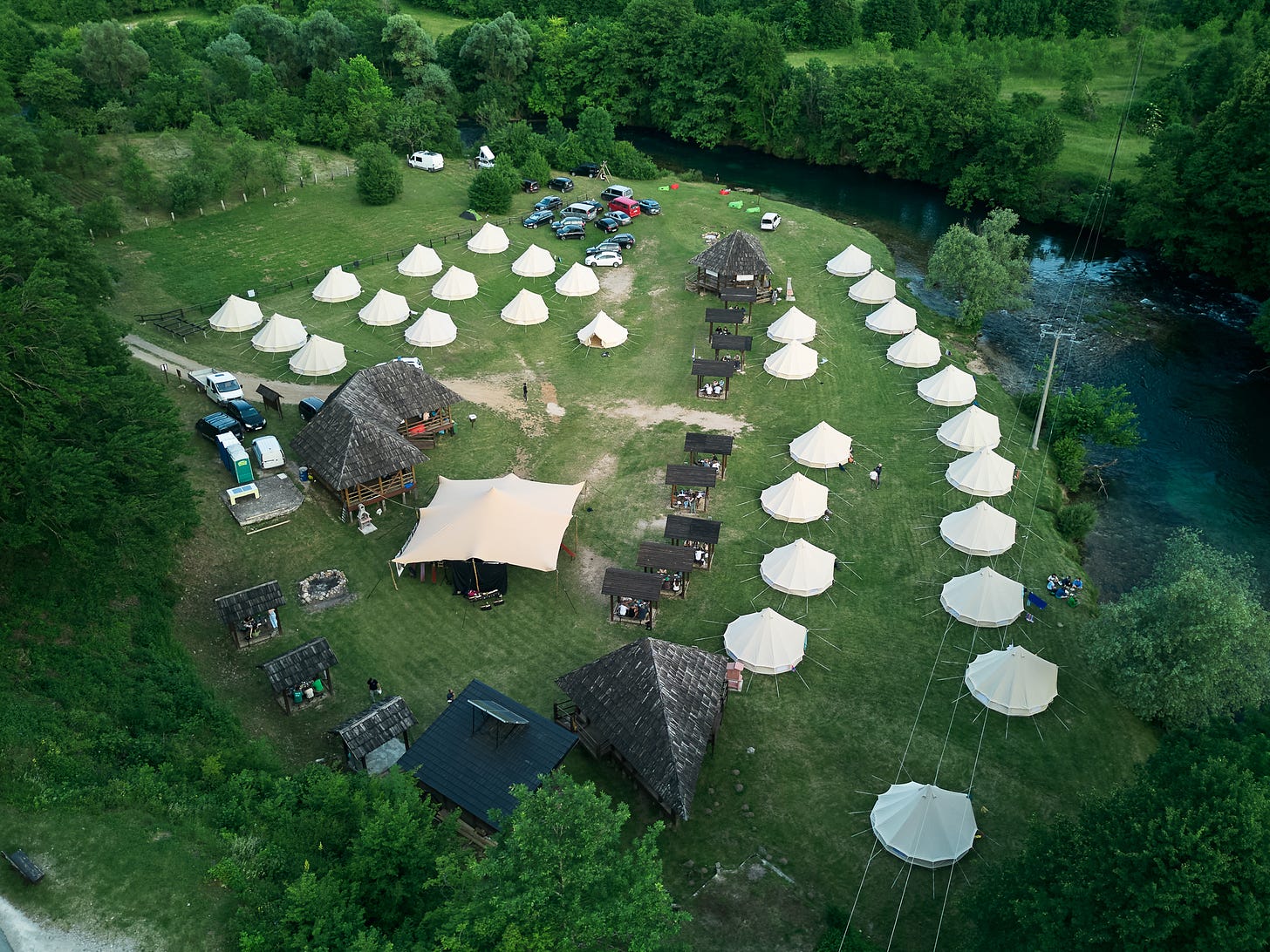
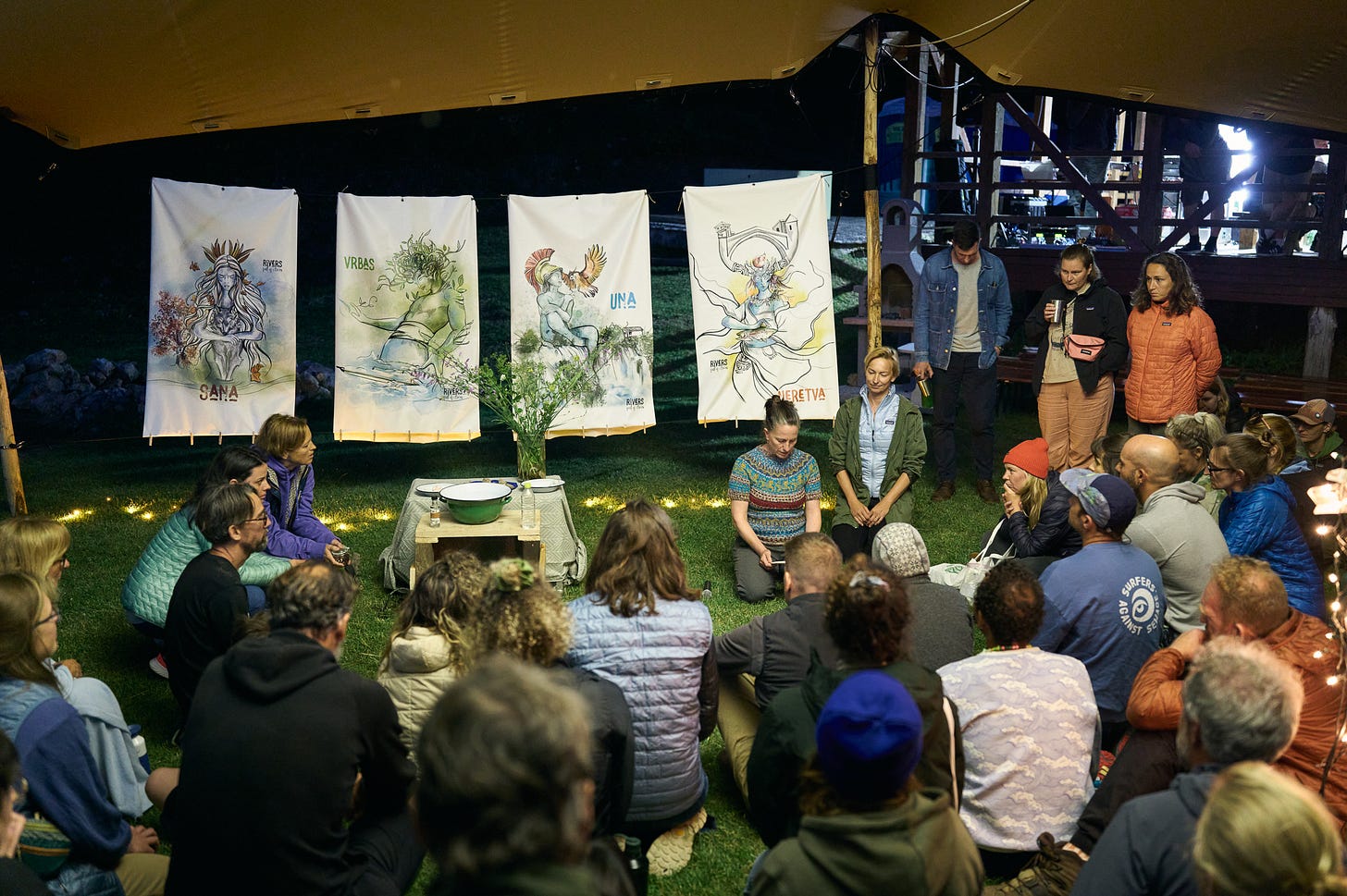
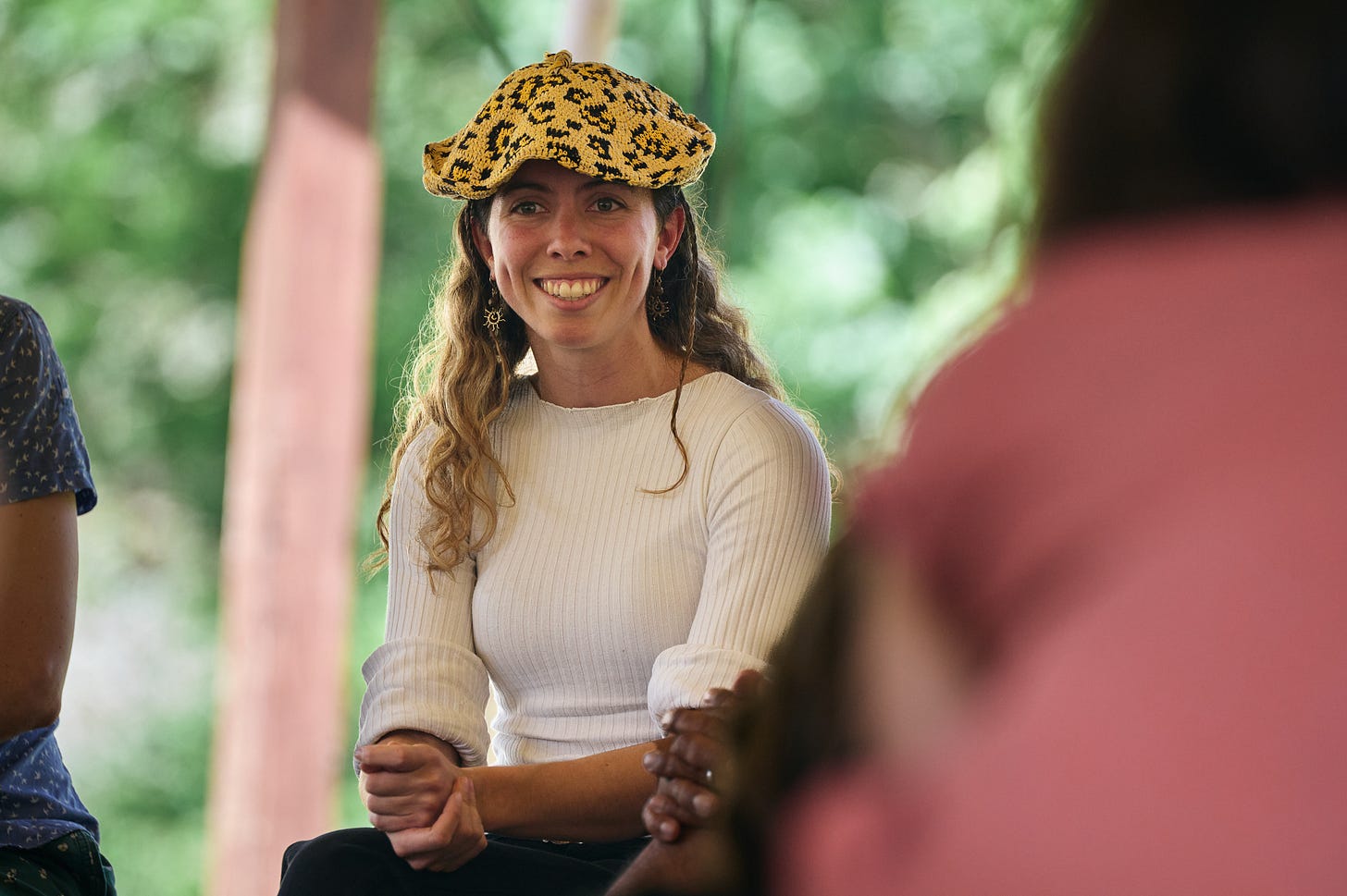
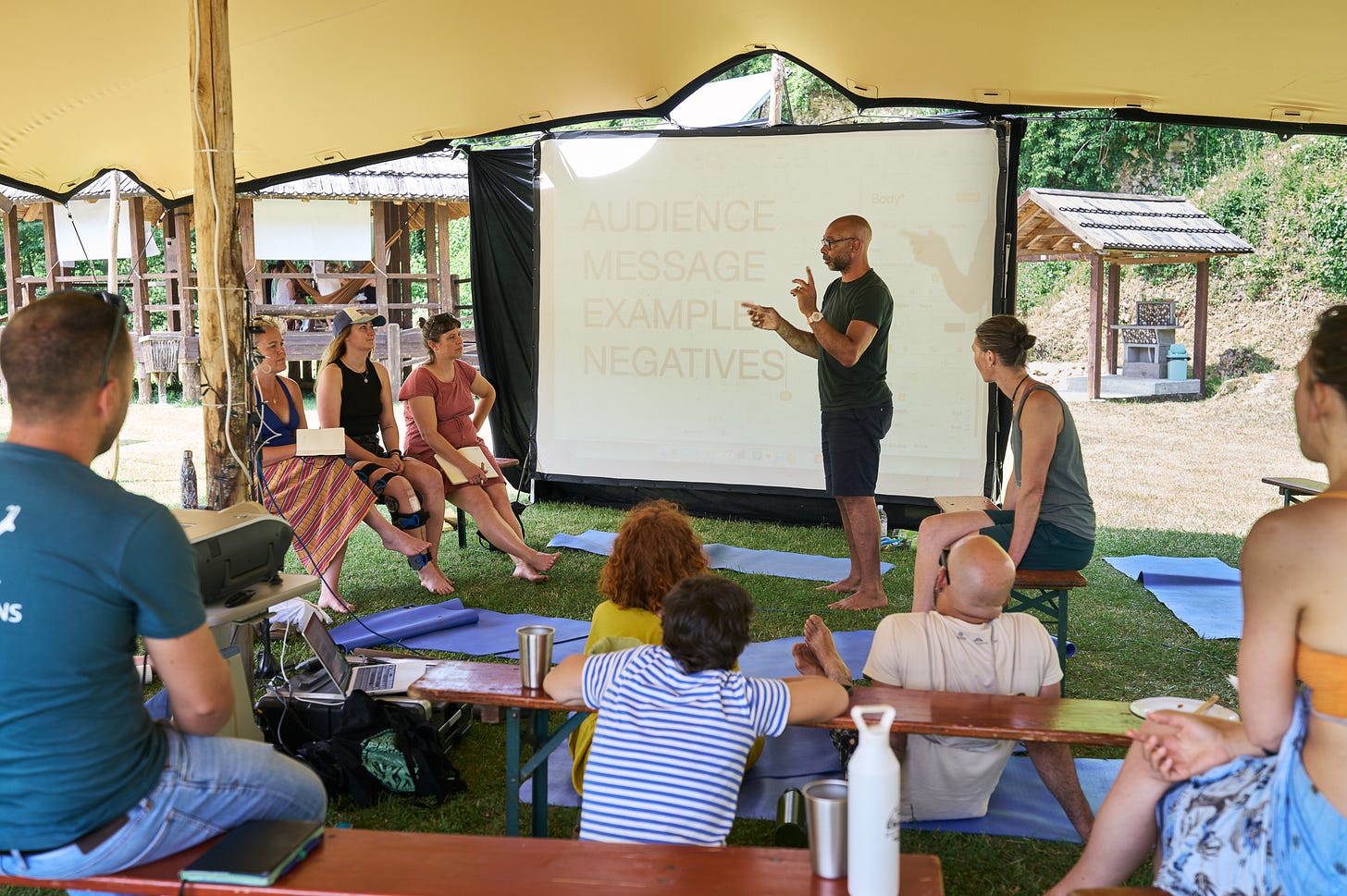
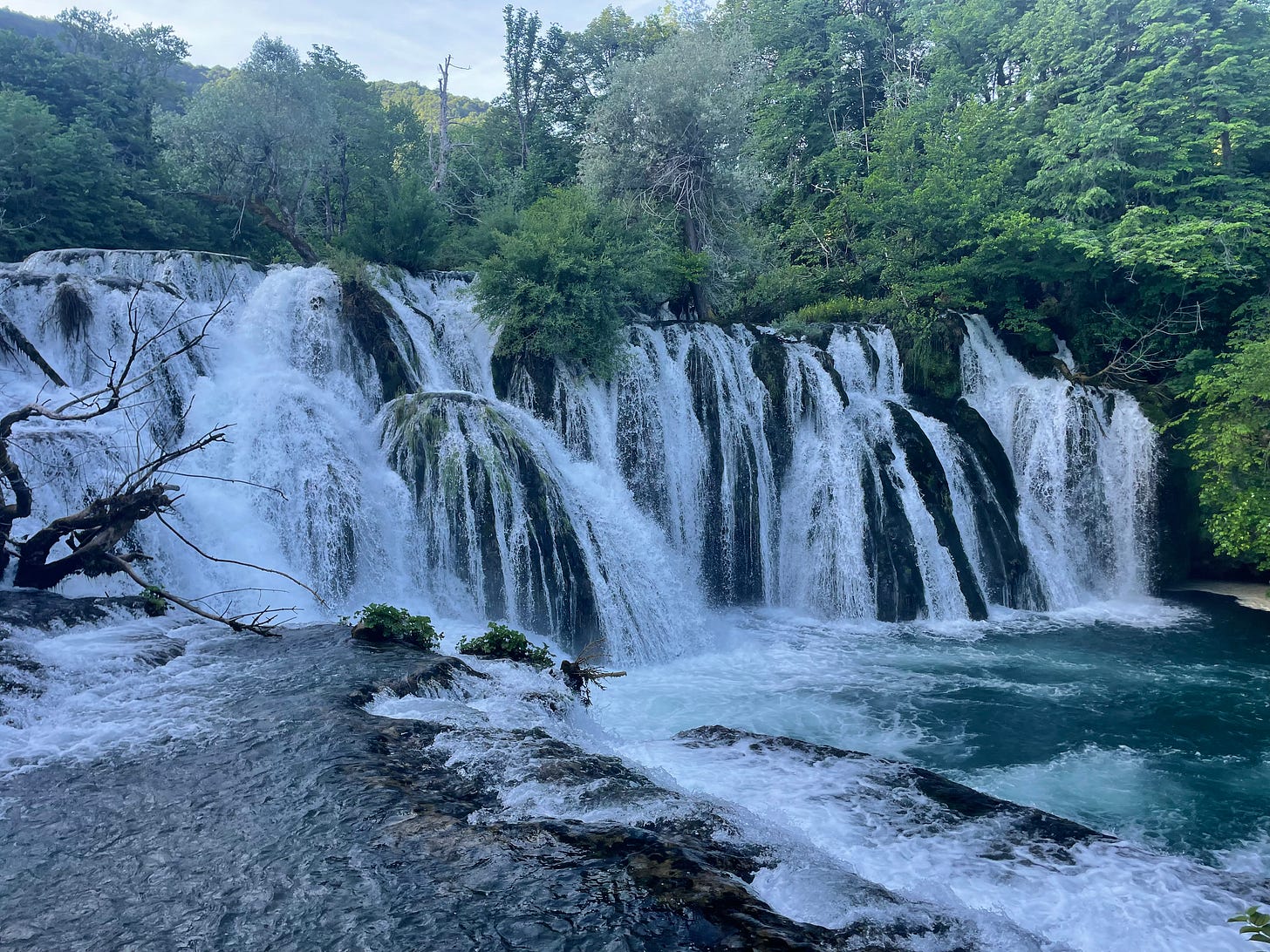
What a fantastic write up of an amazing (if occasionally judgy) experience, Brad! I'm enjoying Tools to Save Our Home Planet and learning a lot. Even for someone who has worked in this space as a strategist and designer, it's eye opening. And as if we needed a reminder of how connected we are to one another, I worked with Grant at Earth Law Center for several years doing their annual reports among other things. He and his team do amazing work ✌🏼